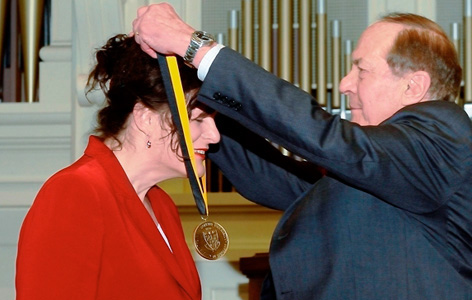Home page Description:
Dr. Stanley was inducted into Society of Scholars for contributions to molecular brain science.
Posted On: April 22, 2015

Image Caption:
Dr. Stanley receiving the Society’s medallion from Johns Hopkins Professor of Neurology Dr. Daniel B Drachman.
TWRI Senior Scientist Dr. Elise Stanley was inducted into Johns Hopkins University Society of Scholars at a ceremony hosted by the Provost, Robert C. Lieberman. The honour was bestowed to Dr. Stanley, along with 15 other inductees, on April 13th, 2015 in Baltimore.
The candidates—a select group of researchers that spent formative years at Johns Hopkins—were chosen by a committee comprising representatives of each academic division of the university. A total of 626 Scholars have been admitted into the Society since its creation in 1969.
Dr. Stanley was recognized for her contributions to synaptic biology in the nervous system, which have provided new insights into how synapses function at the molecular level. Neurons code information as electrical impulses which travel down a nerve fiber to a presynaptic terminal on the target cell. The impulse triggers calcium channels to open, which then gates the release of neurotransmitters and activates the target cell. In 1989 Dr. Stanley developed an experimental model that she used to report the first recordings of single channel calcium currents at a vertebrate presynaptic terminal. A few years later she used this preparation to demonstrate that a single calcium channel can control neurotransmitter discharge, a finding that provides the functional basis for current molecular models of transmitter release site organization.
Congratulations Dr. Stanley!
The candidates—a select group of researchers that spent formative years at Johns Hopkins—were chosen by a committee comprising representatives of each academic division of the university. A total of 626 Scholars have been admitted into the Society since its creation in 1969.
Dr. Stanley was recognized for her contributions to synaptic biology in the nervous system, which have provided new insights into how synapses function at the molecular level. Neurons code information as electrical impulses which travel down a nerve fiber to a presynaptic terminal on the target cell. The impulse triggers calcium channels to open, which then gates the release of neurotransmitters and activates the target cell. In 1989 Dr. Stanley developed an experimental model that she used to report the first recordings of single channel calcium currents at a vertebrate presynaptic terminal. A few years later she used this preparation to demonstrate that a single calcium channel can control neurotransmitter discharge, a finding that provides the functional basis for current molecular models of transmitter release site organization.
Congratulations Dr. Stanley!




